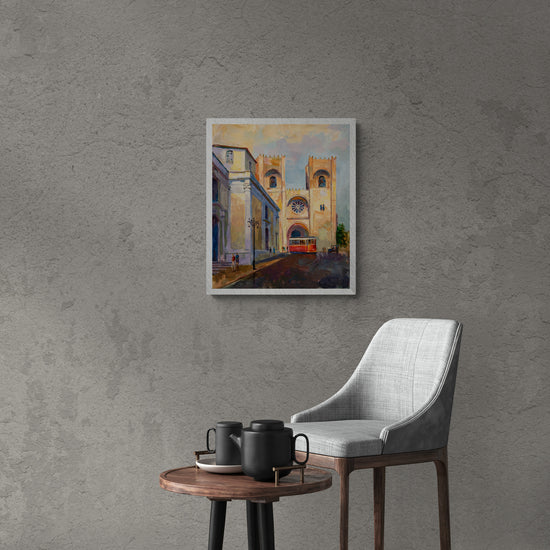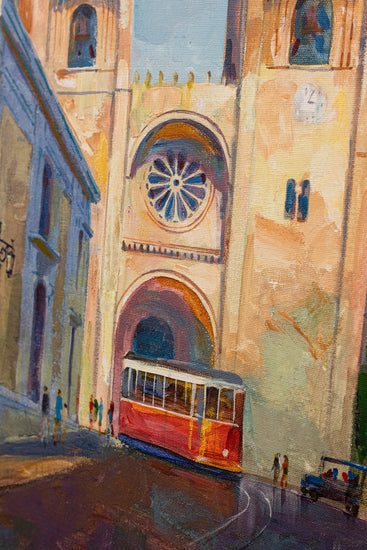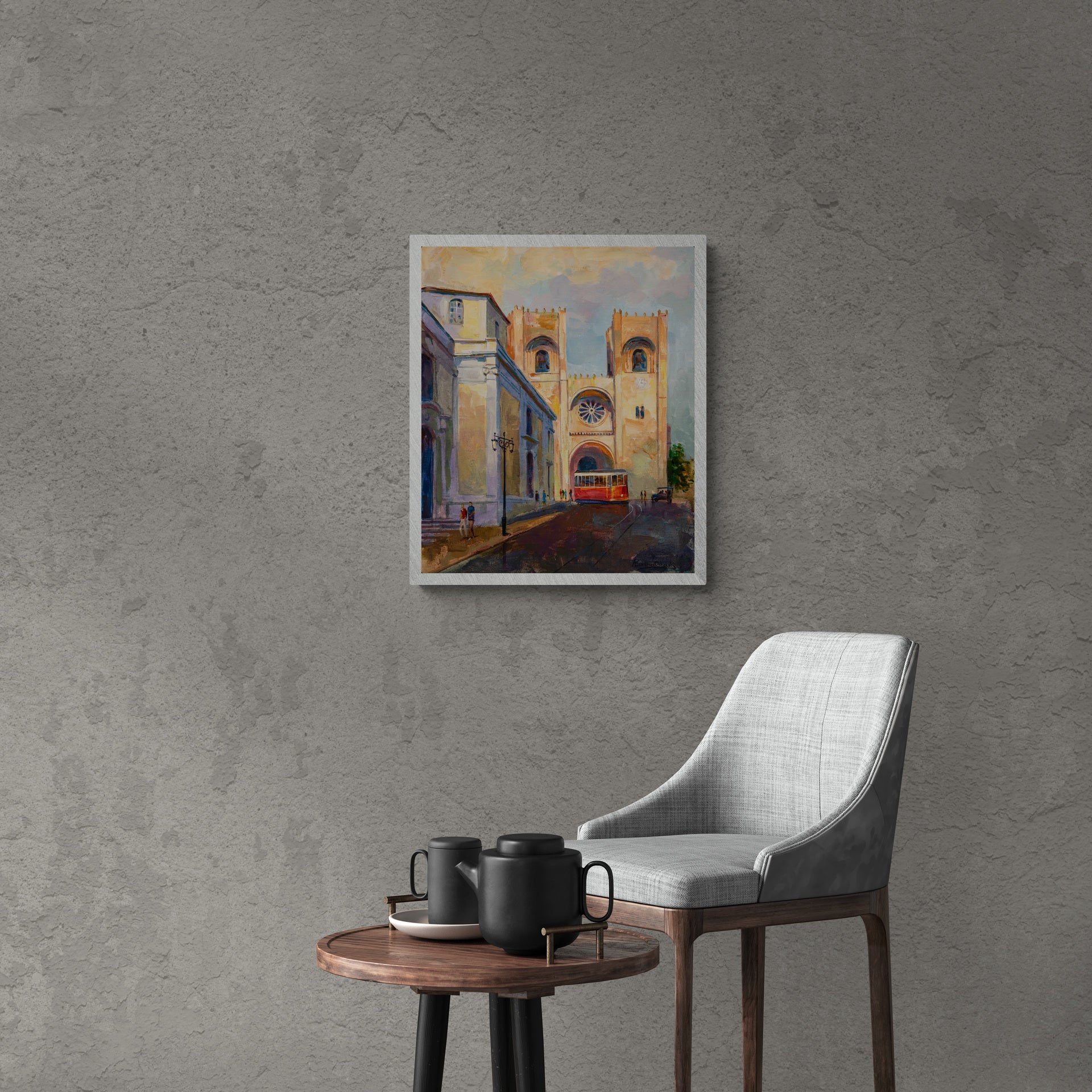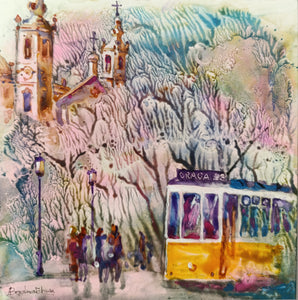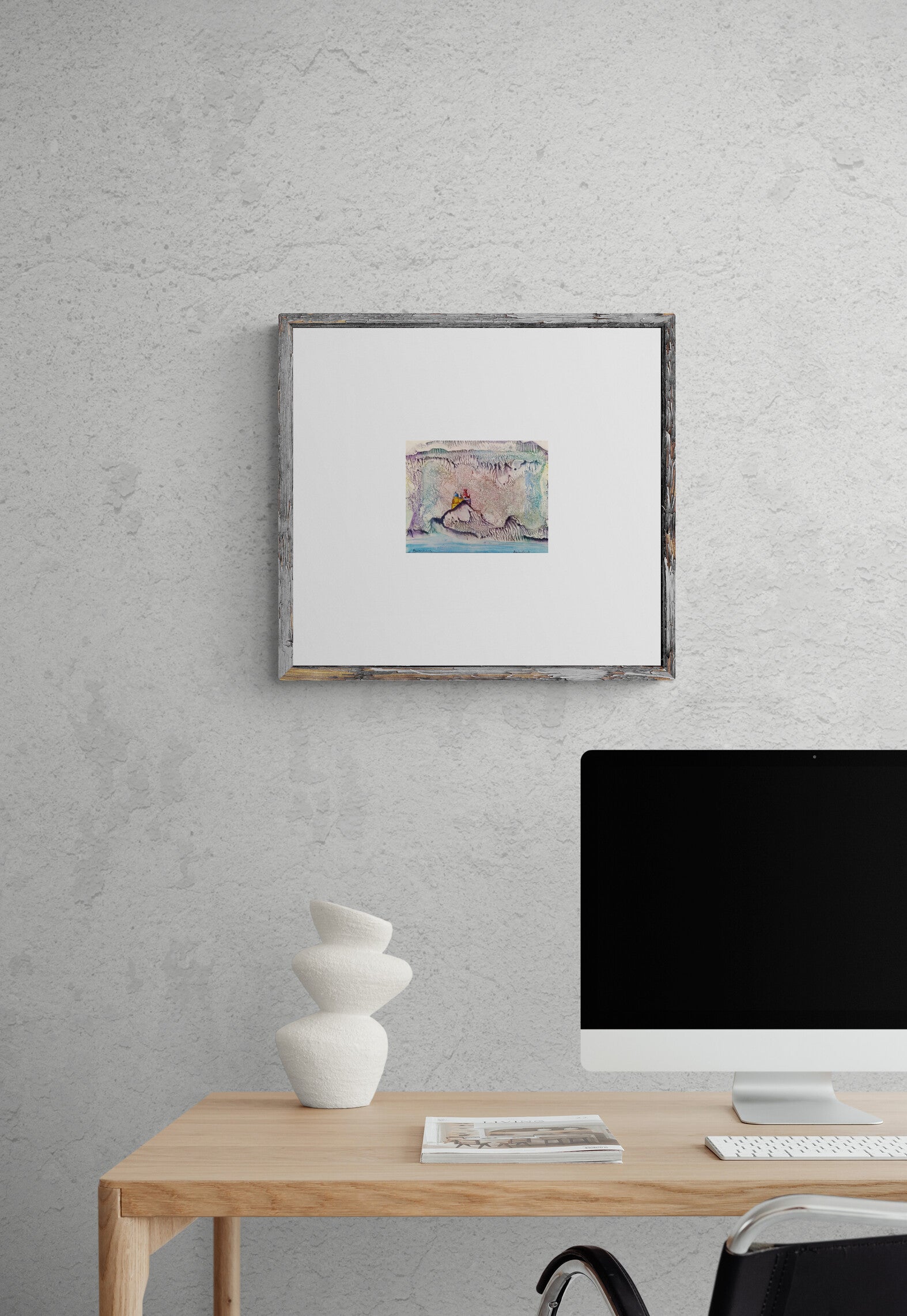Learn more about this product and our services here >
Description
More
Less
Oil on canvas, 55x45x2 cm
The Lisbon Cathedral, also known as the Sé de Lisboa, is a monumental historical structure that has stood since its construction in the mid-12th century. This cathedral embodies a mixture of architectural styles due to multiple reconstructions over the centuries, predominantly Romanesque, but also incorporating Gothic, Baroque, and Neoclassical elements. Its appearance is distinctive and fortress-like, with defensive towers and crenellations that echo its past during the times of the Reconquista.
The interior houses several notable features, including a nativity scene crafted by the sculptor Machado de Castro in 1766 and the font where Saint Anthony was baptized, now adorned with 18th-century tile panels. The Gothic cloisters of the cathedral provide a walk through history with archaeological excavations revealing layers of Lisbon's past, such as Roman, Visigothic, and Moorish structures. These cloisters also hold sarcophagi and tombs of prominent figures like King Afonso IV.
Throughout its history, the cathedral has faced numerous earthquakes, particularly the catastrophic one in 1755, which resulted in the destruction and later reconstruction of parts of the building. The current appearance of the cathedral, which is a result of renovations in the early 20th century, masks some of the damage and changes from past centuries.
The cathedral is not just an architectural marvel but also a custodian of religious artifacts and artworks. Its treasury on the second floor is home to a collection of illuminated manuscripts, silverware, sculptures, and precious gem-inlaid monstrance from the 18th century, showcasing the religious and artistic heritage of Portugal.
Located in the historic heart of Lisbon, the cathedral continues to be a central figure in the religious and cultural life of the city, hosting events and serving as a backdrop to the vibrant history of Portugal.
Return Policy
More
Less
We accept returns. You can return unopened items in the original packaging within 30 days of your purchase with receipt or proof of purchase. If 30 days or more have passed since your purchase, we cannot offer you a refund or an exchange.
Upon receipt of the returned item, we will fully examine it and notify you via email, within a reasonable period of time, whether you are entitled to a return. If you are entitled to a return, we will refund your purchase price and a credit will automatically be applied to your original method of payment.
Only regular priced items may be refunded. Sale items are non-refundable.
Customer Service
More
Less
Refunds do not include any shipping and handling charges shown on the packaging slip or invoice. Shipping charges for all returns must be prepaid and insured by you.
You are responsible for any loss or damage to hardware during shipment.
We do not guarantee that we will receive your returned item. Shipping and handling charges are not refundable. Any amounts refunded will not include the cost of shipping.
Description
Oil on canvas, 55x45x2 cm
The Lisbon Cathedral, also known as the Sé de Lisboa, is a monumental historical structure that has stood since its construction in the mid-12th century. This cathedral embodies a mixture of architectural styles due to multiple reconstructions over the centuries, predominantly Romanesque, but also incorporating Gothic, Baroque, and Neoclassical elements. Its appearance is distinctive and fortress-like, with defensive towers and crenellations that echo its past during the times of the Reconquista.
The interior houses several notable features, including a nativity scene crafted by the sculptor Machado de Castro in 1766 and the font where Saint Anthony was baptized, now adorned with 18th-century tile panels. The Gothic cloisters of the cathedral provide a walk through history with archaeological excavations revealing layers of Lisbon's past, such as Roman, Visigothic, and Moorish structures. These cloisters also hold sarcophagi and tombs of prominent figures like King Afonso IV.
Throughout its history, the cathedral has faced numerous earthquakes, particularly the catastrophic one in 1755, which resulted in the destruction and later reconstruction of parts of the building. The current appearance of the cathedral, which is a result of renovations in the early 20th century, masks some of the damage and changes from past centuries.
The cathedral is not just an architectural marvel but also a custodian of religious artifacts and artworks. Its treasury on the second floor is home to a collection of illuminated manuscripts, silverware, sculptures, and precious gem-inlaid monstrance from the 18th century, showcasing the religious and artistic heritage of Portugal.
Located in the historic heart of Lisbon, the cathedral continues to be a central figure in the religious and cultural life of the city, hosting events and serving as a backdrop to the vibrant history of Portugal.
Return Policy
We accept returns. You can return unopened items in the original packaging within 30 days of your purchase with receipt or proof of purchase. If 30 days or more have passed since your purchase, we cannot offer you a refund or an exchange.
Upon receipt of the returned item, we will fully examine it and notify you via email, within a reasonable period of time, whether you are entitled to a return. If you are entitled to a return, we will refund your purchase price and a credit will automatically be applied to your original method of payment.
Only regular priced items may be refunded. Sale items are non-refundable.
Customer Service
Refunds do not include any shipping and handling charges shown on the packaging slip or invoice. Shipping charges for all returns must be prepaid and insured by you.
You are responsible for any loss or damage to hardware during shipment.
We do not guarantee that we will receive your returned item. Shipping and handling charges are not refundable. Any amounts refunded will not include the cost of shipping.
You May Also Like
join us on instagram





